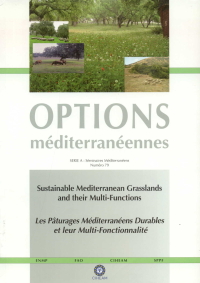| Article précédent | p. 227-230 | Article suivant |
Instantaneous determination of chemical composition of Festuca sp. and Dactylis sp. at two different cut times using near infrared spectroscopy (NIRS)
Near infrared spectroscopy (NIRS) was explored as a technique to predict crude protein, moisture, acid detergent fibre (ADF), neutral detergent fibre (NDF), acid detergent lignin (ADL) and digestibility. The sample set consisted of 123 samples of Festuca arundinacea Schreb and 111 of Dactylis glomerata L. The samples were measured by reflectance NIR in a 1100-2500 nm range. NIR models were developed based on a partial least square regression (PLSR) using different smoothing treatments like absorbance, first derivate and normalization. Calibration models established by near infrared spectroscopy (NIRS) were found to be suitable for the rapid, accurate and non-destructive quantification of Dactylis glomerata L. and Festuca arundinacea Schreb components. Crude protein, moisture and ADF were predicted with an excellent precision (R>0.90). NDF and digestibility calibrations were good because, in spite of having a good coefficient of determination (R>0.90), the errors in Festuca arundinacea Schreb, are slightly high. ADL had a poor prediction power due to the low coefficient of determination (R<0.75).
La spectroscopie dans le proche infrarouge (NIRS) a été exploitée comme une technique pour prédire la protéine totale, l'humidité, la fibre acide détergente (FAD), la fibre neutre détergente (FND), la lignine acide détergente (LAD) et la digestibilité. L'ensemble des échantillons était composé de 123 échantillons de Festuca arundinacea Schreb et 111 de Dactylis glomerata L. Les échantillons ont été mesurés par réflectance dans le proche infrarouge, en utilisant la gamme de longueurs d'onde entre 1100 et 2500 nm. Les modèles NIRS obtenus étaient basés sur la régression par moindres carrés partiaux, et différents traitements de lissage comme l'absorbance, la normalisation et la première dérivée, ont été utilisés. On peut considérer les modèles de calibration comme étant bons en ce qui concerne la rapidité, l'exactitude et la quantification non destructive des échantillons de Dactylis glomerata L. et Festuca arundinacea Schreb. Une excellente précision a été trouvée en protéine totale, humidité et FAD (R>0,90). La prédiction de FND et digestibilité a été considérée comme bonne parce que, malgré ses bons coefficients de détermination, les erreurs trouvées pour Festuca arundinacea Schreb ont été un peu élevées. Concernant LAD, la précision obtenue a été faible à cause d'un coefficient de détermination très petit (R<0,75).
- [ Afficher ]
- [ Télécharger ]
- [ Exporter la citation ]
Vous pouvez télécharger la citation au format :
- [ Imprimer ]
-
Mots-clés
DACTYLIS GLOMERATA, DIGESTIBILITE, FESTUCA ARUNDINACEA, PLANTE FOURRAGERE, PROTEINE VEGETALE, QUALITE, SPECTROSCOPIE INFRAROUGECiter cet article
Poblaciones M.J., Rodrigo S., Simões N., Tavares de Sousa M.M., Bagulho A., Olea L. Instantaneous determination of chemical composition of Festuca sp. and Dactylis sp. at two different cut times using near infrared spectroscopy (NIRS). In : Porqueddu C. (ed.), Tavares de Sousa M.M. (ed.). Sustainable Mediterranean grasslands and their multi-functions . Zaragoza : CIHEAM / FAO / ENMP / SPPF, 2008. p. 227-230. (Options Méditerranéennes : Série A. Séminaires Méditerranéens; n. 79). 12. Meeting of the Sub-Network on Mediterranean Forage Resources of the FAO-CIHEAM Inter-regional Cooperative Research and Development Network on Pastures and Fodder Crop, 2008/04/09-12, Elvas (Portugal). http://om.ciheam.org/om/pdf/a79/00800652.pdf



